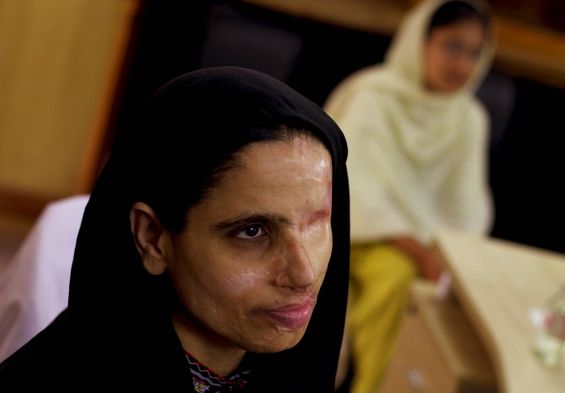
Pulkit Datta
May 30, 2012
The Oscar-winning documentary on acid attacks in Pakistan is a difficult, but incredibly powerful experience
There are some films that evoke an inexplicable mix of anger, pain and inspiration all at the same time. Saving Face, directed by Sharmeen Obaid-Chinoy and Daniel Junge, is one such film, telling the harrowing story of the victims of acid attacks in Pakistan. Winner of the Academy Award for Best Documentary Short and recently screened at the New York Indian Film Festival, Saving Face follows the stories of two women – Zakia and Rukhsana – that try to rebuild their lives with physical and emotional scars in a society that barely punishes the perpetrators of the acid attack.
The directors don’t shy away from showing the full extent of the damage caused by the attacks on these women. For Zakia, her hobby of being photographed in new clothes was ended abruptly when her husband threw battery acid on her face. The result – the entire left side of her face is completely shapeless, as if it just melted away. Her nose is disfigured and the left side of her lips are being pulled upwards as the scar tissue tightens, making it difficult for her to eat or speak.
Rukhsana, an otherwise spirited young woman, bears the equally horrific scars of her acid attack. It ruined the lower half of her face as well as her neck, as she laments the day she married her husband. Rukhsana’s husband threw acid on her, while her sister-in-law poured gasoline and her mother-in-law lit the matchstick. While the women are locked in legal battles with the men that attacked them, in a judicial system that doesn’t have a clear law in place for such crimes, they also try to overcome the painful process of emotional healing and a severe loss of self-confidence.
Zakia wraps herself up completely every time she steps out of her home, using her burqa as a shield more than anything else. Large black sunglasses then cover her eyes, as she tries her best to be completely hidden from public view, the loss of self-confidence crippling her in many ways. Thus we see the first layer of ’saving face’, a constant effort by the women to literally hide their faces from a society that is both unwilling to punish the assailants and is also unprepared to see the consequences of the acid attacks.
Meanwhile, their husbands outright deny their crime and in turn blame the women for what happened. One husband’s father even adds sarcastically, “Women are doing a lot of ‘great’ things these days, such as cutting our noses.” Obaid-Chinoy and Junge are careful not to show the husbands in a judgmental light. Instead, they allow the men to say what they want and let the viewer make the verdict instead. It’s not a surprise whose side you will take, but it is a storytelling technique that successfully enrages you, making you want to to do something to help these women fight for justice.
Luckily, this is where the second layer of ’saving face’ comes in, as the women’s path soon crosses with charitable work of London-based, Pakistani-born plastic surgeon Dr. Mohammed Jawad. Dr. Jawad visits the Burns Center in Islamabad every few months, and offers the women reconstructive surgery. It’s a chance to literally save their face.
As Dr. Jawad works with Zakia and Rukhsana on their individual reconstructive surgeries, he realizes that his biggest challenge is “to manage expectations”. But he isn’t alone in the efforts to help these women move on. Obaid-Chinoy and Junge also follow parliamentarians that are pushing a bill that calls for severe punishment for those convicted of such attacks. It is passed unanimously. There is also a support group that brings victims of acid attacks together to share their stories and find strength in each other.
Saving Face is a difficult film to watch, because it confronts you so vividly with a major problem, and a horrific one, that exists in our world. It’s not just about Pakistan, but about the struggle to end violence against women in every part of the world. Obaid-Chinoy and Junge present the stories of Zakia and Rukhsana not in a depressing or demoralizing light, but celebrate the small steps these women take to regain control of their lives. Some unsung heroes, like Dr. Jawad and the parliamentarians, are also worth highlighting. In that way, the film is inspiring. But the statistic opening the film explains that each year, over 100 women are victims of acid attacks. And for that reason, there is still plenty of work to be done. |

